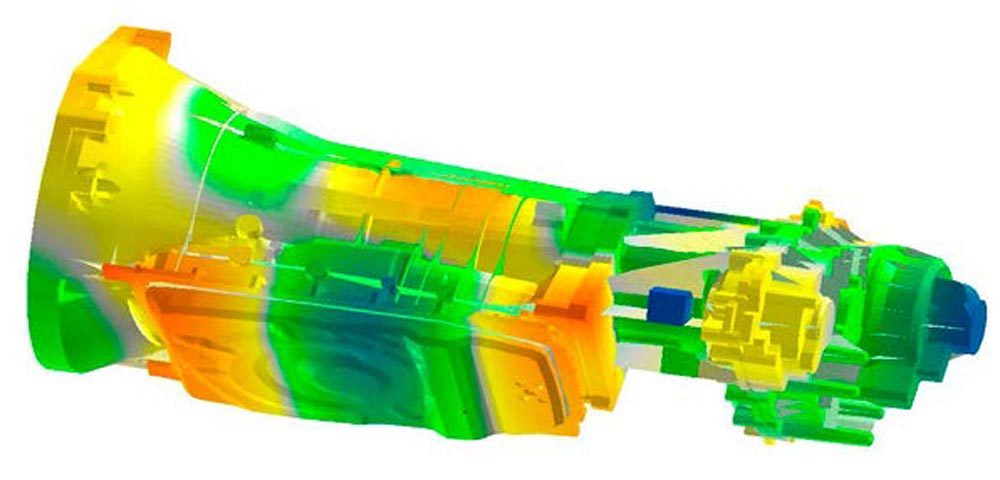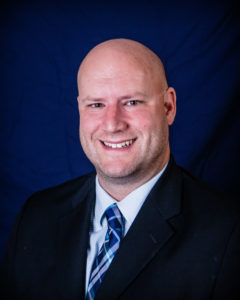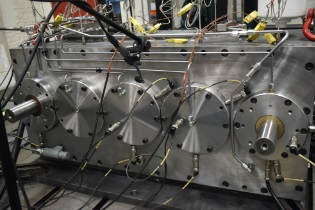The Evolution of Gear Dynamics and Gear Noise
Raj Singh reflects on the short courses and gear research at Ohio State University

Illustration of typical noise calculations from practical gear casing structures, as covered by Prof. Raj Singh in his lectures.
A deep dive into the world of gear dynamics and gear noise has led many a mechanical engineer to Columbus, OH in search of the methods by which gear noise is measured and predicted as well as the techniques employed in gear noise and vibration reduction. Over the past 40+ years, about 2,550 engineers and technicians from 385+ companies have attended the Gear Dynamics and Gear Noise Short Course at The Ohio State University.
“Our audience is diverse ranging from gear designers, test engineers, manufacturing engineers, noise and vibration specialists, CAE professionals to even fresh graduates from engineering colleges. Introductory overview lectures are useful to the gear designer with minimal knowledge of noise and vibration analysis as well as to the noise specialist with little knowledge of gears,” said Raj Singh, emeritus professor, department of mechanical and aerospace engineering, The Ohio State University.
Given the diverse needs within the gear industry, Singh said attendees always find something that has a direct relevance to their work or the current problems they are facing.
The course was founded by Prof. Don Houser in 1978, and Dr. Singh joined in 1979. Initially, two lecturers from the UK participated as well to provide the European and historical context. The course continued to evolve based on the progress made on the research front, and now it is taught by a team of world-class experts, led by Professors Singh, Kahraman and Talbot.
“In the early days (spanning four decades), we focused just on the gear whine, design methods and measurements. Gradually, we introduced other topics which were the by-products of OSU’s Gear Lab research since the 1980s. These include gear contact analysis and robust design calculations, CAE tools for static, dynamic, and acoustic analyses, transmission error measurements using modern instrumentation, gear rattle, etc.,” Singh said. “In the coming years, we may introduce timely topics such as e-vehicle geared drives, high speed gear dynamics, tribology issues, and the like. There has been a great synergy between the short courses and the gearing research carried out at Ohio State. As a result, Ohio State is a premier institution for research, graduate education, and training of gear industry practitioners.”
Given the fact that gear noise is a hot topic due to the push for electrification across the automotive and transportation industries, it’s not surprising to see these conversations come up regularly at Ohio State.
“We have started to mention the electrification issues in several lectures especially the motor excitation frequencies, torque pulsations, dynamics associated with high-speed operations and so on. Of course, we must introduce more e-mobility topics in the future offering of the short course. Synergy with the Gear Lab will also bring in the latest methods or tools to the course,” he added.
Gear noise, however, has been a challenge for several manufacturing segments through the years.
“Industries that find this course helpful include transportation, off-highway vehicles, wind-energy, process machinery, aircraft, appliance, robotics, and all gear manufacturers, in addition to automotive (including the e-vehicles),” Singh said.

Laboratory tour and demonstration led by Prof. Ahmet Kahraman, discussing advanced gear whine and rattle excitation measurements
An Inside Look at the Lectures
The Gear Dynamics and Gear Noise Short Course is a comprehensive overview that bolsters classroom discussions with real-world examples. On day one, lecturers discuss why even perfect gears make noise. They present in both qualitative and quantitative terms how gear design parameters and manufacturing errors affect noise. The concept of gear transmission error, one of the major contributors to gear noise, is developed, and methods of predicting transmission errors from design and manufacturing data are presented. Participants get a clear physical insight into the problems they face and how they may apply course knowledge to help solve their gear noise problems.
On day two, lecturers concentrate on gear system dynamics and acoustics, dynamics of parallel axis and planetary gears, transmission error calculations and measurements. The role of spacing error is also discussed. The third day’s lectures briefly discuss the sources of gear rattle and design robustness for whine problems as well as spending several hours in the case history workshop. (see the preliminary agenda at nvhgear.org/home.html).
Case History Workshop
This novel approach to discussing “real life” gear noise and dynamics problems has been used in this course since its inception. The workshop, which has been lauded by past attendees for its practical flavor, takes place on the third day of the course. The purpose of this workshop is to allow the course instructors and participants to interact and to discuss gear noise and dynamics case histories presented by course attendees. They are asked to present a brief synopsis of problems they have encountered or of a procedure they have used for gear noise analysis and reduction. Possible approaches to solve each problem will be discussed.
Laboratory Exercises
“Most attendees eagerly look forward to the laboratory and computer software demonstrations that are used to illustrate gear noise measurement and analysis techniques. The unmatched facilities of the Gear and Power Transmission Research Laboratory (gearlab.org) and the Acoustics and Dynamics Laboratory (mae.osu.edu/adl) are utilized for such demonstrations,” Singh said.

Gear Lab tour led by Prof. Isaac Hong, illustrating some of exceptional experimental facilities.
An Adaptive Training Course
The course is of particular interest to people involved in the analysis, manufacture, design specification, or utilization of simple and complex gear systems. Topics range from transmission error (the main source of gear whine), measurements for gear noise diagnosis, noise, vibration and perception issues, gear tooth, shaft and bearing, dynamics, profile design, and manufacturing issues and transmission paths and housing acoustics.
Singh said the analysis tools as well as the methods to address gear noise are changing as we approach 2024.
“Faster and more efficient calculations for both components and systems are of interest. Yet another one is the integration of various CAE tools. In fact, the verification (such as comparison of two analysis tools) and validation (comparing predictions with measurements) issues are arousing more interest as attendees are raising those questions. We will enhance the presentations to emphasize these issues in the future.”
Multiple areas of a gearbox assembly must be analyzed to come up with the most effective tools to combat gear noise, according to Singh.

Discussion of gearbox vibration and acoustics by Prof. Raj Singh as part of the laboratory demonstrations
“Primary sources such as the transmission errors and mesh stiffness variations should be addressed first. Beyond that, secondary issues such as sliding friction, misalignments, spacing errors, ghost noise, bearing clearances and the like should be examined depending on the customer complaints or measurements. Thus, a structured problem-solving approach is needed based on design targets and application perspectives,” Singh said.
In the future, Singh said the education may include the use of AI in design optimization and diagnostics, development of digital twin tools, application of 3D printing methods to gearbox components, ultra-precision machining or finishing methods, etc.
The next Gear Dynamics and Gear Noise Short Course takes place June 3–6, 2024. Go to nvhgear.org/home.html for additional details.







